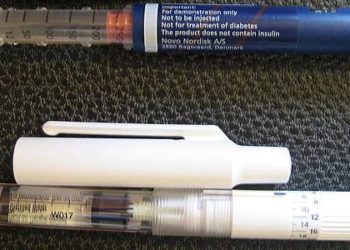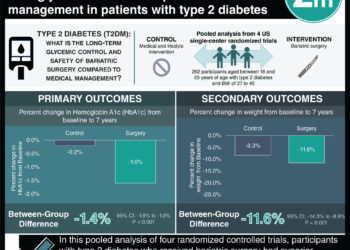Study identifies distinct hemoglobin A1c patterns in adolescents over time
1. Across 3 international registries, 5 similar patterns of hemoglobin A1c (HbA1c) were identified: low stable, intermediate stable, high stable, target increase, and high increase.
2. Older adolescents at time of diagnosis and minorities were more likely to experience poor glycemic control.
Evidence Rating Level: 2 (Good)
Study Rundown: The importance of good glycemic control for individuals living with type 1 diabetes (T1D) is well known. Youth living with T1D are a sub-population that often do not meet glycemic targets, with a concerning trend in the rise of hemoglobin A1c (HbA1c) over time. This study aimed to identify patterns in HbA1c over time in youth from the time of diagnosis of T1D. In total, across 50,222 youth included in the analysis, 5 patterns of HbA1c were similarly identified across 3 international registries. Minorities were more likely to be categorized under the high stable group and target increase group as compared to the low stable group. Older individuals at time of diagnosis were more likely to fall under the high increase group, which was the least common pattern. Variables such as insurance status, BMI, socioeconomic status, as well as insulin treatment regimens were not collected, and their effect on HbA1c trajectories could not be analyzed. Overall, results indicate that despite varying HbA1c at diagnosis, there are similar patterns experienced by adolescents internationally. This provides an opportunity for clinicians to identify adolescents at risk of poor glycemic control and intensify diabetes education and treatment to prevent worsening of their disease process.
Click to read the study in PEDIATRICS
Relevant Reading: Effect of continuous glucose monitoring on glycemic control in adolescents and young adults with type 1 diabetes: A randomized clinical trial
In-Depth [retrospective cohort]: This retrospective cohort study assessed data from 3 international registries that included Australia, New Zealand, Austria, Germany, Luxembourg, Switzerland, and the United States. In total, 50,222 youth diagnosed with T1D prior to age 18 were included. Youth had to have a minimum of 1 HbA1c value in the first year after diagnosis, with at least 3 years of HbA1c values over 10 years. Five HbA1c trajectories were identified across all 3 registries: low stable (25%), intermediate stable (44%), high stable (i.e., HbA1c >8.0%, 15%), target increase (i.e., linear rise in HbA1c to be above target within 2 years of diagnosis, 11%), and high increase (i.e., progressive deterioration of glycemic control, 5%). The high increase pattern included a higher frequency of ethnic minorities (p<0.0001) and older adolescents at time of diagnosis (p<0.001) as compared to the low stable group across all 3 registries. The target increase group similarly had a higher percentage of minorities as compared to the low stable and intermediate stable groups.
Image: PD
©2021 2 Minute Medicine, Inc. All rights reserved. No works may be reproduced without expressed written consent from 2 Minute Medicine, Inc. Inquire about licensing here. No article should be construed as medical advice and is not intended as such by the authors or by 2 Minute Medicine, Inc.







